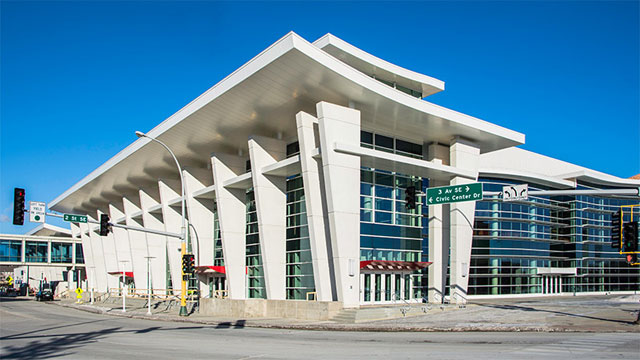Aging buildings often use a lot of unnecessary electricity, and two key facilities in Rochester—Rochester Recreation Center and Mayo Civic Center—had many opportunities for energy savings. This case study highlights improvements at both centers that have increased efficiency and will extend the life of these important community hubs.
Two Centers in Need of Upgrades: The Rochester Recreation Center, constructed in 1974, contains two ice arenas, a gymnasium, a pool, offices and locker rooms and is home to several hockey programs, a figure skating club, and a swim club. The facility had an aging ice plant refrigeration system, needed mechanical improvements to address occupant comfort and dehumidification concerns, outdated lighting, and was using multiple systems to control the equipment. At 115,000 square feet, it was an energy hog. Across town, the Mayo Civic Center had recently completed a major expansion but still had outdated lights and controls from as far back as the 1980s in the original building.
Enter the Guaranteed Energy Savings Program. The Guaranteed Energy Savings Program, or GESP, is a state-led program that delivers technical, financial, and contractual assistance to state agencies, cities, counties and schools to support the implementation of energy conservation measures using pre-qualified Energy Savings Performance Contracting companies. These companies are a one-stop shop for state and local governments to pay for new efficient equipment and services with no upfront capital costs, while guaranteeing that cost savings will meet or exceed payments for equipment and services over the contract period. Both the Rochester Recreation Center and the Mayo Civic Center entered into GESP and partnered with the same Energy Savings Performance Contracting company—McKinstry.
Recreation Center Improvements: Under the guidance of GESP, McKinstry developed an energy-efficient design concept for the Recreation Center and calculated the savings resulting from the new rink system, which included heat recovery, new innovative efficient equipment configurations, and new efficient control strategies. The $2.2 million project is expected to generate over $100,000 in utility savings with annual operating costs reduced by another $45,000. Total kilowatt hours will be reduced by a whopping 3.3 million kWh, the same as eliminating the electricity use of over 300 Minnesota homes.

Mayo Civic Center Improvements: The Mayo Civic Center project included a comprehensive lighting upgrade to LEDs, improved lighting controls, a retrofit of the audio system, and new building controls. Each of these improvements saves energy and reduces the carbon emissions of the facility, and extends the life of the building’s infrastructure. In addition to creating a more comfortable environment for the facilities 300,000 visitors, the Civic Center will save $185,000 a year on its utility bill.
Could your facilities benefit from similar upgrades? The potential for other local governments and schools to replicate Rochester’s example is significant. The Environmental Protection Agency estimates that nearly one-third of the energy used to run typical government buildings goes to waste. Saving this energy not only helps the environment but frees up taxpayer money for other needed priorities.
Click here to learn more about GESP or contact Peter Lindstrom, CERTs Local Government Outreach Coordinator, at 612-625-9634 or plindstr@umn.edu.
 About the Local Government Energy Action Series:
About the Local Government Energy Action Series:
This effort tells the stories of Minnesota municipalities, counties, and schools and the tangible results of their energy-saving efforts to inspire others to take their own actions. See all stories in this series >>

from MN Energy Stories Blog from CERTs https://www.cleanenergyresourceteams.org/blog/rochester-recreation-center-and-mayo-civic-center-make-comprehensive-energy-efficiency
No comments:
Post a Comment